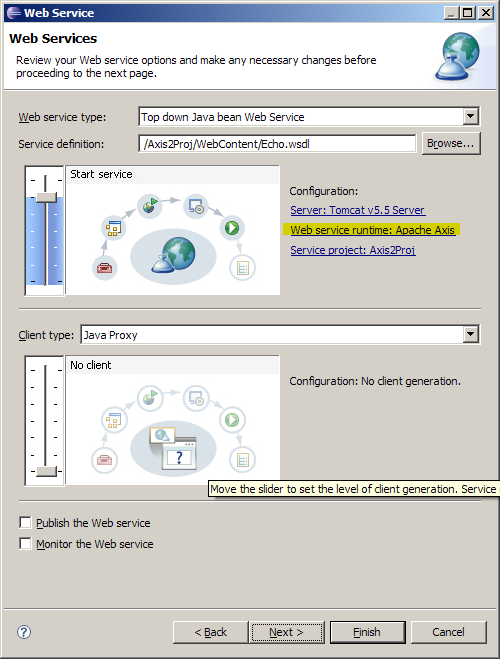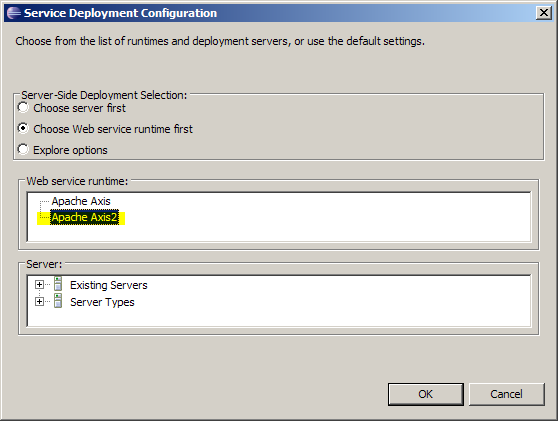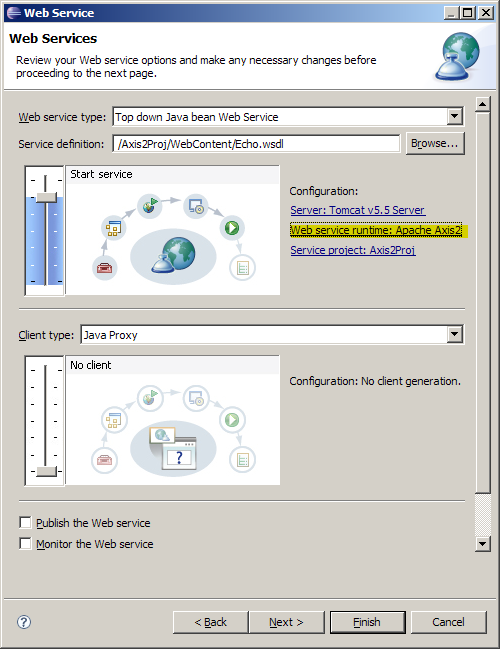Eclipse Web Tools Platform
2.0 | Back |
Web Services
Axis2 Web Services tools
-
The Web services tools now supports the Axis2 version
1.2 Web services runtime.
First, install the Axis2 v1.2 runtime using the Web services preference:

Second, create a dynamic Web project adding the Axis2 facets:

To choose the Axis2 Web service runtime, click the Web service runtime hyperlink on the Web Service wizard or Web Service Client wizard.

Choose the Axis2 runtime,

Then, you can create Axis2 bottom up Web service, top down Web service and Web service client using the existing Web services tools.

Refer to the following Axis2 Web services tutorials for details:
Web Services tools supports Axis 1.4
-
The Web services tools have been updated to support Axis
1.4 instead of Axis 1.3.
Adding optional mergerClass attribute to the Web Services implementation type extension
-
A new optional attribute "mergerClass" is introduced in
the Web services implementation type extension point
org.eclipse.jst.ws.consumption.ui.wsImpl. This
mergerClass should implement the newly defined
org.eclipse.wst.ws.internal.wsrt.IMerger interface which
contains a load() and merge() method. This class is used
for the purpose of Web services skeleton file merging
for the Web service implementation type. A
org.eclipse.jst.ws.internal.consumption.common.JavaMerger
has been defined for the Java Web service implementation
type.
Web services pop-ups now takes custom types
-
Adopters of the Web services creation framework can now
use the same Web services pop-ups provided by the framework
to process their custom types. They just need to provide an IAdapterFactory
that adapts that custom type to IFile or String and register the factory
with the Platform's AdapterManager (or extends the
org.eclipse.core.runtime.adapters
extension). The Web services pop-ups that currently take advantage of this
look up mechanism are:
- Web service wizard,
- Web service client wizard, and
- Test with Web Services Explorer .
Web Services Explorer
SOAP Header support
-
The Web Services Explorer provides form and source views for working with Web
service SOAP requests and responses. It used to only provide the means for
working with the contents of the SOAP body.
Now, the Web Services Explorer can work with the SOAP header as well.

Pluggable transport and message stack
-
A new extension point has been added to the Web Services
Explorer:
org.eclipse.wst.ws.explorer.wseTransportProvider
-
Interfaces:
- ISOAPMessage - This interface represents a SOAP message in a web service invocation made by the Web Services Explorer's transport stack.
- ISerializer - The ISerializer is responsible for taking an ISOAPMessage and serializing it into an XML string.
- IDeserializer - The IDeserializer is responsible for taking an XML string and deserializing it into values to populate an ISOAPMessage.
-
Classes:
- MessageContext - A MessageContext object holds information about the message that is to be sent on a web service invocation.
- SOAPMessage - This is a default implementation of the ISOAPMessage interface that extenders of the Web Services Explorer transport can use.
-
exceptions:
- TransportException - A general purpose exception to indicate a problem has occurred when invoking a web service.
- HttpTransportException - A type of TransportException that can be thrown when the transport protocol is HTTP.
This extension point entry allows an extender to plug in a new factory for creating org.eclipse.wst.ws.internal.explorer.transport.ISOAPTransport instances. The ISOAPTranport is used by the Web Services Explorer for invoking Web services operations that uses the SOAP message protocol. The factory must implement the org.eclipse.wst.ws.internal.explorer.transport.ISOAPTransportProvider interface.
Other classes/interfaces which are part of this API are as follows:
These classes/interfaces are found in the org.eclipse.wst.ws.internal.explorer.transport package.
General
New Internet preferences
-
The Internet preference page that used to be under
Internet->Proxy Settings is now under
General->Network Connections.

